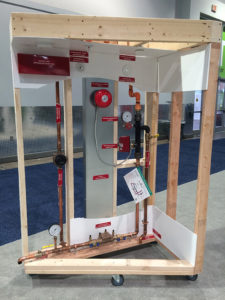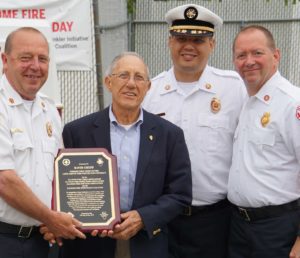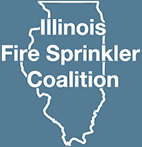Tom Lia, executive director, Northern Illinois Fire Sprinkler Advisory Board
 Thirty years ago, Dave Grupp, who was the fire chief of the Long Grove Fire Protection District, had a vision; to protect all new construction homes with automatic home fire sprinklers. Long Grove did not have fire hydrants. Chief Grupp knew that fire sprinklers were the only technology that prevents a fire from becoming deadly, allowing everyone to safely escape while the fire department responds. Working closely with elected officials, Long Grove was the first village in Illinois to pass a home fire sprinkler ordinance on April 11, 1988.
Thirty years ago, Dave Grupp, who was the fire chief of the Long Grove Fire Protection District, had a vision; to protect all new construction homes with automatic home fire sprinklers. Long Grove did not have fire hydrants. Chief Grupp knew that fire sprinklers were the only technology that prevents a fire from becoming deadly, allowing everyone to safely escape while the fire department responds. Working closely with elected officials, Long Grove was the first village in Illinois to pass a home fire sprinkler ordinance on April 11, 1988.
Long Grove also was one of the first villages with a successful activation. Three days before Thanksgiving in 2001, a fire started in a 9-year-old child’s bedroom. Filled with stuffed animals, the fire was hot enough to activate two sprinklers that controlled the fire and prevented deadly flashover. The homeowner and children evacuated the home and called 9-1-1. When the fire department arrived, they extinguished a small amount of smoldering material under the bed. The homeowner admitted that she would not have chosen to have a sprinkler system installed in the home if it was an option and not a requirement.
Most people who die in fires die where they feel safest— in their homes (80%). A home fire can become deadly in as little as two minutes (NFPA.) The contents in our homes, including our furniture, are made of plastics and synthetics that burn hotter and faster, as well as produce toxic deadly smoke (UL/NIST.). Common unprotected lightweight building materials, certain types of flooring, and open architectural designs also cause fires to spread quickly.
There is a growing concern for firefighter health, safety, and exposure to contaminants that result from fires. Firefighters are 11 times more likely to be injured fighting a home fire.
Chief Grupp is the person who started it all in Illinois and showed true leadership in unchartered waters. He paved the way for other fire chiefs to educate decision makers and their communities to understand the importance of protecting their citizens and firefighters. He also was the first chief to say that a new home built without fire sprinklers is a substandard home. Today, 104 Illinois communities and districts have passed ordinances, protecting thousands of homes and the people who live in them.
If you are a real estate agent and haven’t shown a sprinklered home yet, it is only a matter of time. It is important to understand how a fire sprinkler works so you can answer homebuyer questions. The most common myth is that the entire system will activate. That is not true. Heat from a fire, not smoke, causes the sprinkler to activate. Only the sprinkler closest to the fire will go off, not the entire system. Home fire sprinklers provide added value and peace of mind, a major selling point.
The child who lived in the house that was saved when sprinklers controlled the fire in his bedroom is now 26-years old. You can only imagine how different life may have been for that family without fire sprinklers.
 Thank you Chief Grupp for your vision.
Thank you Chief Grupp for your vision.
The Northern Illinois Fire Sprinkler Advisory Board (NIFSAB) has a list of real estate agents with experience selling homes protected with fire sprinklers. Visit http://firesprinklerassoc.org/realestate to see the list. If you would like to be added to the list, contact Tom Lia, [email protected].
Click here for the list of Illinois communities that require home fire sprinklers in new homes.
The non-profit Home Fire Sprinkler Coalition provides real estate professionals with information to help answer homebuyer questions about home fire sprinklers. Visit: https://homefiresprinkler.org/selling-a-home-protected-by-fire-sprinklers/

